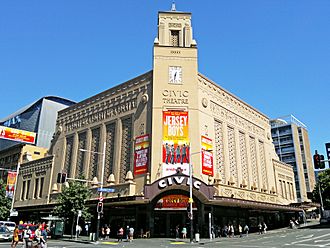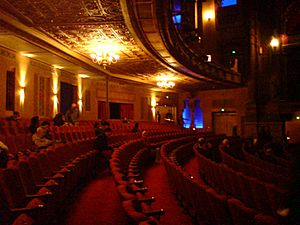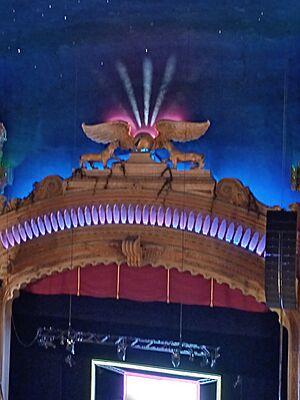Civic Theatre (Auckland) facts for kids
Quick facts for kids Civic Theatre |
|
|---|---|

The theatre from the front
|
|
| General information | |
| Type |
|
| Architectural style | Moorish Revival |
| Address | 267 Queen Street |
| Town or city | Auckland |
| Country | New Zealand |
| Coordinates | 36°51′04″S 174°45′50″E / 36.851072°S 174.763920°E |
| Inaugurated | 20 December 1929 |
| Renovated | 1998–1999 |
| Owner | Auckland Unlimited, Auckland Council (indirectly through Auckland Unlimited) |
| Landlord | Auckland Live |
| Design and construction | |
| Architect | Charles Bohringer and William T. Leighton |
| Main contractor | Fletcher Construction |
| Other information | |
| Seating capacity | 2,378 |
| Designated: | 27 June 1985 |
| Reference #: | 100 |
The Civic Theatre is a very special building in Auckland, New Zealand. It's a large theatre that hosts live shows, music concerts, and movies. It first opened its doors on December 20, 1929.
What makes the Civic Theatre so unique is its "atmospheric theatre" style. This means the inside of the theatre is designed to look like you're sitting outdoors at night. It has a ceiling that twinkles like stars! The theatre was closed for a big renovation in the late 1990s and reopened exactly 70 years after it first opened, on December 20, 1999. Today, it's managed by Auckland Live.
Contents
Why the Civic Theatre is Special
The Civic Theatre is important around the world. It's the biggest "atmospheric cinema" still standing in Australia and New Zealand. It was also the first cinema of its kind built in New Zealand.
Unique Design and Art
The theatre is famous for its amazing design. The entrance area, called the foyer, looks like it's from India. It has statues of seated Buddhas, twisted columns, and round, domed ceilings.
The main theatre room is also very exotic. It looks like a Moorish garden with small towers, tall spires, and tiled roofs. You'll also see two life-sized panther statues near the stage!
Size and Capacity
When it first opened, the Civic Theatre could hold 2,750 people. Even with fewer seats today (2,378), it's still the largest theatre in New Zealand.
History of the Civic Theatre
The idea for the Civic Theatre came from a man named Thomas O'Brien. He was a movie businessman in Auckland in the 1920s. He wanted to bring the "atmospheric cinema" style to New Zealand. He had already opened a similar theatre in Dunedin in 1928.
Building the Dream Theatre
O'Brien convinced some wealthy Auckland business people to help build a huge atmospheric cinema on Queen Street. He even got a large loan from the Bank of New Zealand. The company Fletcher Construction built the cinema in just eight months. The total cost was quite high, which even caught the attention of the New Zealand Parliament.
With supreme confidence in the future of Auckland, and with gratitude to those who have toiled with me in this great endeavour, I present to my fellow citizens the consummation of an ideal – the creating of a place of entertainment symbolising the progressive spirit of our beautiful city.
—Thomas O'Brien
Early Challenges
The Civic Theatre opened with a lot of excitement in December 1929. However, soon after, the Great Depression started, which was a time when many people had less money. This meant fewer people could afford to go to the theatre. Also, O'Brien preferred to show British films, but American films were more popular at the time. Because of these challenges, he eventually faced financial difficulties.
Over the years, the theatre was changed a few times. But in the late 1990s, it was carefully restored to look much like its original design.
The Wintergarden and World War II
The Civic complex also has an underground ballroom called the Wintergarden. During World War II, many American soldiers were stationed in Auckland. The Wintergarden became a popular place for them to go for entertainment. Famous people like Bob Hope performed there. Important figures like Eleanor Roosevelt and General Bernard Montgomery also gave speeches.
Saving the Theatre
By the 1960s, the Civic Theatre faced difficulties. It was very large, which wasn't ideal for smaller movie audiences. Also, a new theatre, the Aotea Centre, opened nearby in the 1990s, creating more competition.
In 1993, the Auckland City Council took over the building's lease. They even thought about tearing it down! But a group called the "Friends of the Civic" started a campaign to save it. Thanks to their efforts, the council decided to spend money to fix up the theatre. It reopened in 1999 for both movies and live shows. The Wintergarden reopened in 2000.
A Movie Star Theatre
The Civic Theatre even became famous in a movie! Its interiors were used in Peter Jackson's 2005 movie King Kong. In the film, the Civic Theatre pretended to be a New York theatre called The Alhambra.
See also
 In Spanish: Teatro Civic (Auckland) para niños
In Spanish: Teatro Civic (Auckland) para niños



